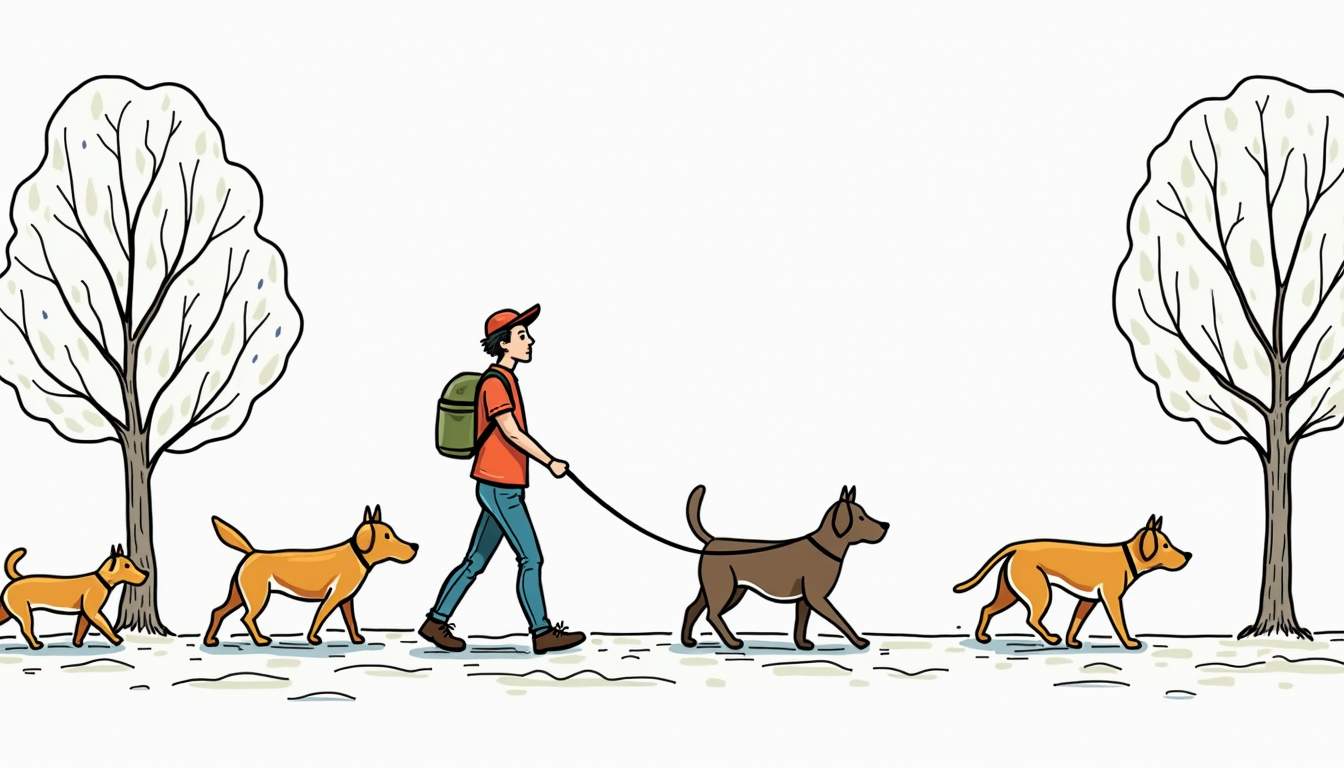
Regular dog walks are not just a routine chore for pet owners; they are a vital component of a dog’s overall health and well-being. The simple act of walking can have profound effects on a dog’s physical, mental, and emotional health. This article explores the multifaceted benefits of regular walks for dogs, highlighting how they contribute to a happier, healthier canine companion.
The Physical Benefits of Dog Walking
One of the most apparent benefits of regular dog walks is the enhancement of physical health. Dogs, like humans, require regular exercise to maintain their physical condition. Walking helps to keep their muscles strong, their hearts healthy, and their weight in check.

Weight Management
Obesity is a growing concern among pets, leading to various health issues such as diabetes, joint problems, and heart disease. Regular walks help burn calories and promote a healthy metabolism. For dogs that are already overweight, a consistent walking routine can be the first step toward shedding those extra pounds.
Incorporating different terrains and distances can also keep the walks interesting and engaging. Whether it’s a leisurely stroll around the neighborhood or a brisk hike in the woods, varying the intensity can help dogs maintain a healthy weight while enjoying the outdoors. Additionally, using a pedometer or a fitness tracker can provide motivation for both the owner and the dog, encouraging them to reach daily step goals and explore new routes, which can lead to exciting discoveries and new experiences. For expert tips and personalized dog walking plans, visit Four Dog Paws today.
Muscle and Joint Health
Walking is a low-impact exercise that strengthens muscles and supports joint health. Regular movement helps to maintain flexibility and range of motion, which is particularly important for older dogs or those with existing joint issues. The act of walking can also stimulate the production of synovial fluid, which lubricates joints and helps to prevent stiffness.
For puppies, early walks can lay the foundation for a lifetime of healthy habits. It’s crucial to ensure that the walks are appropriate for their age and development stage, as overexertion can lead to injuries. Engaging in short, frequent walks can help puppies develop strong muscles and coordination, while also providing them with essential socialization opportunities. Meeting other dogs and people during these outings can bolster their confidence and reduce anxiety, fostering a well-adjusted adult dog.
Heart Health
Just like humans, dogs benefit from cardiovascular exercise. Regular walks can improve heart health by increasing circulation and lowering blood pressure. A healthy heart is essential for overall vitality and longevity. Engaging in consistent physical activity helps to reduce the risk of heart disease, ensuring that dogs remain active and energetic throughout their lives.
Moreover, walking can also have a positive impact on the mental well-being of both dogs and their owners. The rhythmic nature of walking can reduce stress levels and promote relaxation, making it an excellent way to bond with your furry friend. The sights, sounds, and smells encountered during walks can stimulate a dog’s senses, providing mental enrichment that is just as important as physical exercise. This combination of physical activity and sensory engagement can lead to a happier, more balanced pet, enhancing the overall quality of life for both dog and owner.
The Mental Health Benefits of Walking
Walking is not just about physical exercise; it also plays a significant role in a dog’s mental well-being. Dogs are naturally curious creatures, and walks provide an opportunity for mental stimulation and exploration.
Reducing Anxiety and Stress
Regular walks can help alleviate anxiety and stress in dogs. The exposure to new sights, sounds, and smells during walks can provide mental enrichment, keeping their minds engaged. This stimulation can help reduce behavioral issues that often arise from boredom or pent-up energy.
Additionally, the routine of daily walks can create a sense of stability and predictability for dogs, which can be comforting. For dogs that experience separation anxiety, walks can serve as a distraction and a way to release pent-up energy before being left alone.
Socialization Opportunities
Walking in public spaces exposes dogs to other dogs and people, providing essential socialization experiences. Positive interactions during walks can help dogs develop good manners and reduce fear or aggression towards unfamiliar stimuli. This socialization is particularly important for puppies, as early experiences can shape their behavior as adults.
Moreover, walking with other dog owners can create a sense of community, enhancing the social lives of both dogs and their owners. These interactions can lead to friendships and support networks, enriching the lives of everyone involved.
Emotional Benefits of Regular Walks
The bond between a dog and its owner can deepen through shared activities like walking. This time spent together fosters trust and companionship, leading to a more harmonious relationship.

Strengthening the Human-Dog Bond
Walking together allows for quality time that strengthens the bond between a dog and its owner. Dogs thrive on companionship, and regular walks provide an opportunity for interaction and connection. During walks, owners can engage with their dogs through verbal praise, petting, and play, enhancing the emotional connection.
Moreover, the shared experience of exploring the environment can create lasting memories, reinforcing the bond between pet and owner. This emotional connection can lead to a happier, more well-adjusted dog.
Boosting Mood and Happiness
Regular walks not only benefit dogs but also their owners. Engaging in physical activity can release endorphins, leading to improved mood and reduced stress levels for both parties. The simple act of being outdoors, enjoying nature, and spending time with a beloved pet can be incredibly uplifting.
For many dog owners, walks become a cherished routine that enhances their overall quality of life. The joy of seeing a dog wagging its tail and enjoying the fresh air can bring a sense of happiness and fulfillment.
Practical Tips for Effective Dog Walking
While the benefits of walking are clear, it’s essential to approach dog walking with intention to maximize its advantages. Here are some practical tips to ensure that dog walks are effective and enjoyable for both the dog and the owner.
Establish a Routine
Consistency is key when it comes to dog walking. Establishing a routine helps dogs know what to expect and when. Whether it’s a morning stroll or an evening outing, regularity can enhance the benefits of walking. Aim for at least 30 minutes of walking each day, adjusting the duration based on the dog’s age, breed, and health status.
Creating a schedule can also help owners prioritize this important activity amidst busy lifestyles. Setting reminders or incorporating walks into daily routines can make it easier to stay committed.
Choose the Right Gear
Having the right gear is crucial for safe and enjoyable walks. A well-fitted collar or harness is essential for control and comfort. For dogs that pull on the leash, a no-pull harness can make walks more manageable.
Additionally, consider investing in a sturdy leash that provides enough length for freedom while maintaining control. For nighttime walks, reflective gear can enhance visibility and safety.
Be Mindful of the Environment
When walking dogs, it’s essential to be mindful of the environment. Choose safe and suitable areas for walks, avoiding busy streets or places with excessive noise that may frighten the dog. Parks, trails, and quiet neighborhoods can provide enriching experiences.
Always clean up after the dog to maintain a clean environment and be respectful of others. This practice not only promotes community responsibility but also ensures that the walking experience remains positive for everyone involved.
Addressing Common Challenges
While dog walking is beneficial, it can come with its challenges. Understanding and addressing these issues can make the experience more enjoyable for both the dog and the owner.

Dealing with Pulling
Many dogs tend to pull on the leash during walks, which can be frustrating for owners. Training techniques such as positive reinforcement can help teach dogs to walk politely on a leash. Using treats or toys as rewards for walking beside the owner can encourage good behavior.
Additionally, practicing loose-leash walking in low-distraction environments before venturing into busier areas can help dogs learn to focus and stay close.
Handling Distractions
Dogs are naturally curious and can easily become distracted during walks. Whether it’s another dog, a squirrel, or an interesting smell, distractions can lead to challenges in maintaining focus. Training commands such as “leave it” or “focus” can help redirect a dog’s attention when they become overly excited.
Gradually exposing dogs to various distractions during walks can also help them learn to remain calm and focused, making walks more enjoyable and productive.
Adjusting for Weather Conditions
Weather can significantly impact the walking experience. On hot days, it’s essential to walk dogs during cooler times, such as early morning or late evening, to prevent overheating. Providing plenty of water and taking breaks in shaded areas can help keep dogs comfortable.
In colder weather, consider using dog jackets or booties to protect against the elements. Always monitor dogs for signs of discomfort, and adjust the duration and intensity of walks accordingly.
Conclusion
Regular dog walks are a cornerstone of canine health, offering an array of physical, mental, and emotional benefits. From maintaining a healthy weight and promoting cardiovascular health to enhancing the bond between dog and owner, the advantages are undeniable. By establishing a consistent walking routine, choosing the right gear, and being mindful of the environment, both dogs and their owners can enjoy the numerous rewards that come with this simple yet impactful activity.
Ultimately, the joy of walking a dog goes beyond exercise; it’s about creating shared experiences, fostering connections, and enriching the lives of both pets and their humans. So, grab that leash and step outside—adventure awaits!